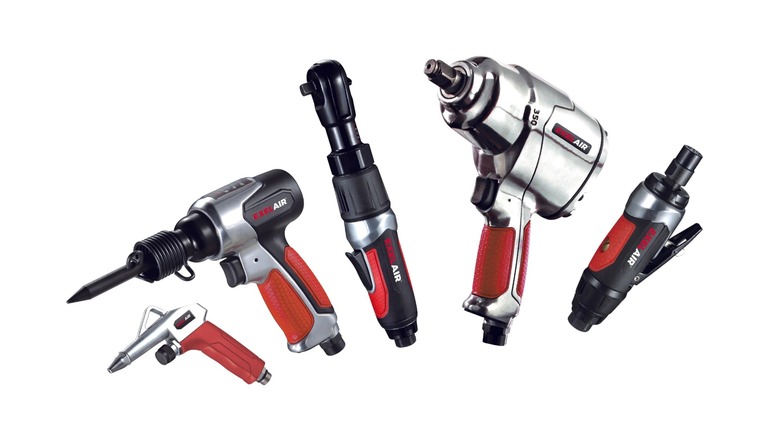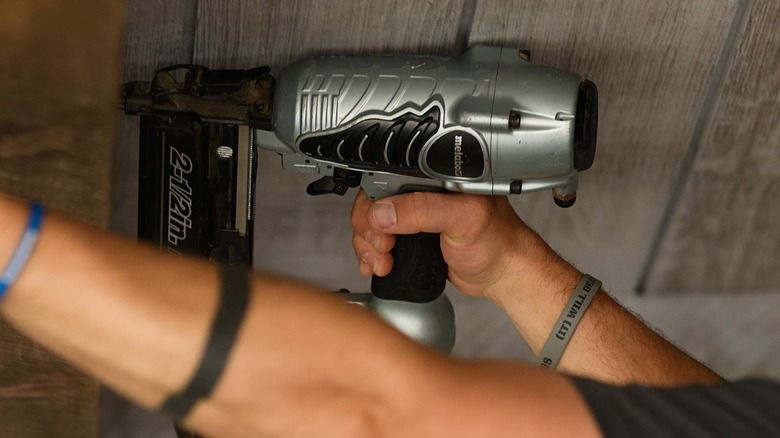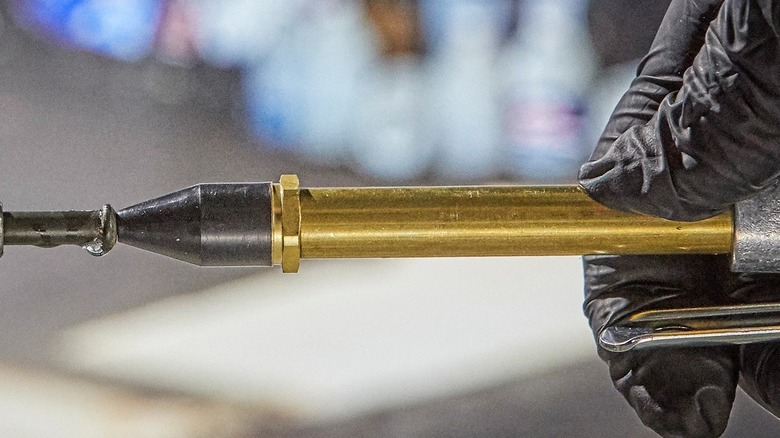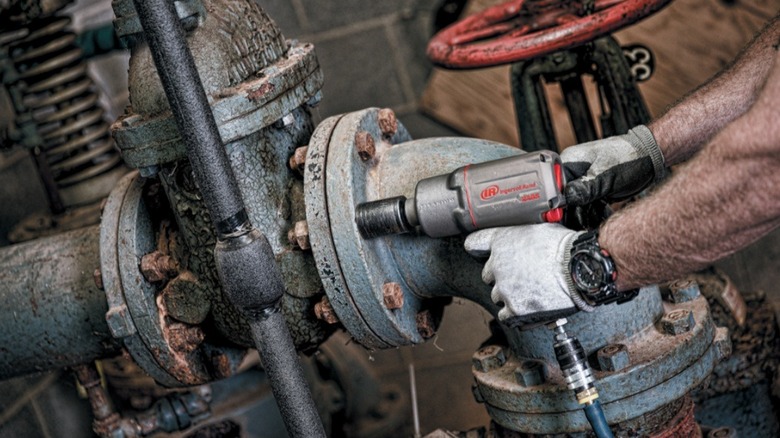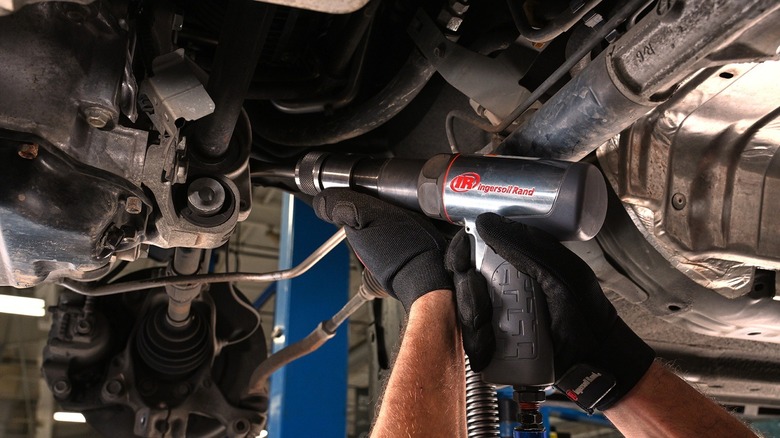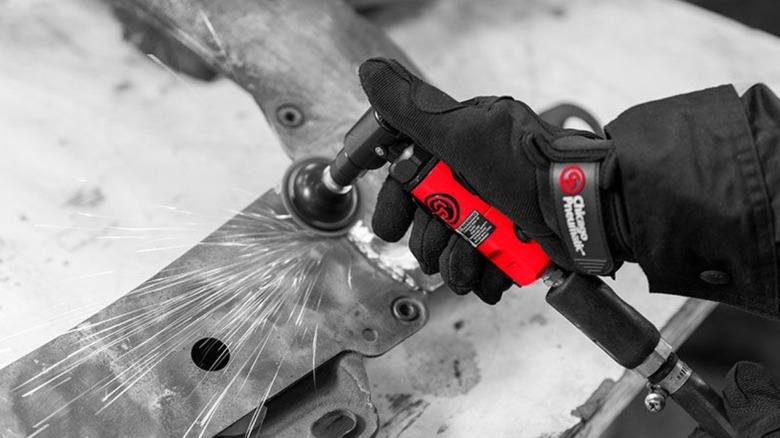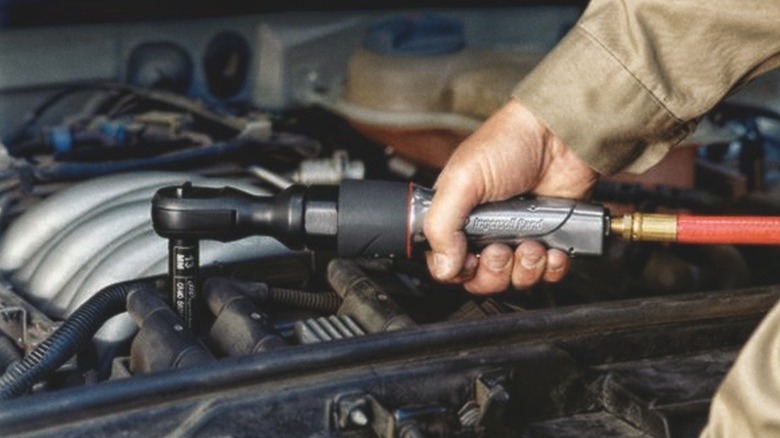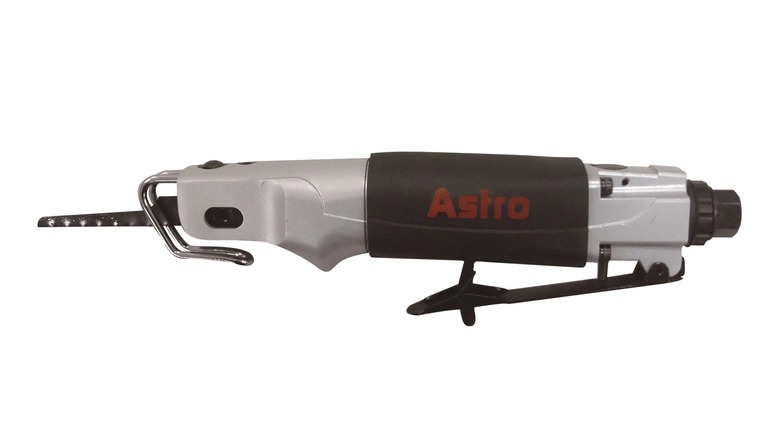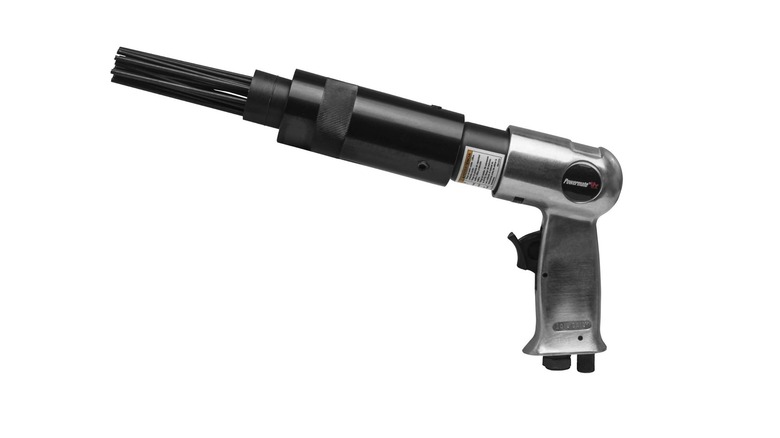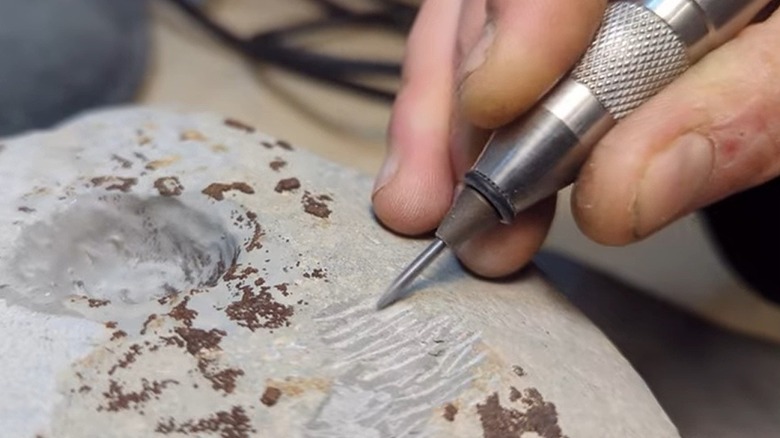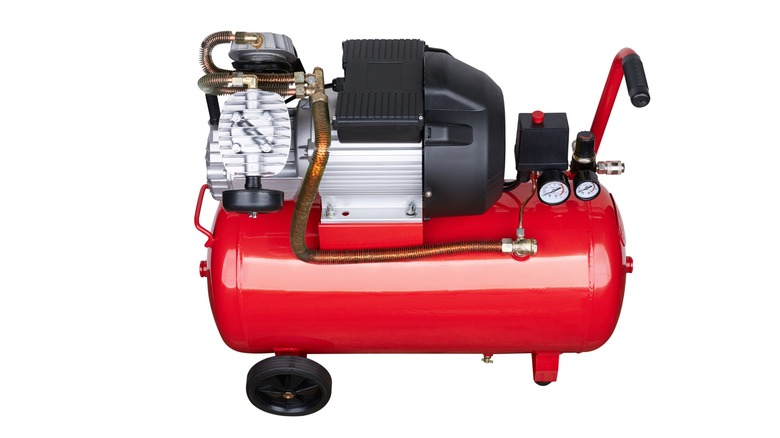9 Highly-Rated Air Compressor Tools To Add To Your Collection
We may receive a commission on purchases made from links.
Most of us are familiar with gas-powered tools and electric power tools, but there is another kind of power tool — air powered. An air compressor can be used to top off tires or fill up an air mattress, sure, but with the right peripheral tools an air compressor can do so much more. Check out our air compressor buyers guide if you're looking to add an air compressor to your shop.
Air tools have a number of benefits over their gas-powered or electric alternatives. They tend to be comparatively lightweight because they don't have to carry heavy batteries or fuel tanks with them and they don't need a conventional motor to do work. That lightweight profile can be a significant benefit on big jobs, because you can work more efficiently for longer without fatigue. Ditching a motor in favor of pressurized air also means air tools usually have simpler construction, are less prone to malfunctions, and last longer. They're typically more affordable as well.
Electric or gas-powered tools run the risk of overheating and battery-powered tools need regular battery replacements to keep running. For those reasons, and many others, air tools are often the ideal choice for continuous work or for working in unconventional environments like confined spaces, wet workspaces, or areas containing flammable materials. These are some of the most highly rated air compressor tools to add to your workshop.
Metabo HPT 2-inch 18-gauge pneumatic straight brad nailer
Powered nail guns come in various shapes and sizes depending on the sort of job you need to do. Heavy duty nailers can be used to put up framing or build a deck, while smaller nailers can be used to apply finishing nails or brad nails during detail and finish work.
No matter what you choose, pneumatic nailers use pressurized air to drive a nail into wood in a single swift motion. Nails enter the nailer in a connected strip and are separated inside as you use them. Since you can drive nails almost instantaneously, pneumatic nailers can shave significant time off big construction jobs.
If you're inexperienced with pneumatic nail guns, the relatively small size and power of the Metabo HPT 2-inch 18-gauge pneumatic straight brad nailer is a great place to start. At only 2.2 pounds, you can use it for extended periods without fatigue and it's covered by a five-year manufacturer warranty. It uses small brad nails, roughly 1/20 an inch in width designed for use in trim and detail work. The small size means driven nails are less likely to split wood and nearly invisible at a glance. In addition, this Metabo product has also earned thousands of positive reviews across a variety of sellers.
Milton S-153 1/4-inch NPT lever style blow gun
Air guns are about as simple a pneumatic tool as you can get, but they shouldn't be overlooked. Consisting of a nozzle connected to an airline running to your air compressor, blow guns are designed to deliver a directed stream of pressurized air in an easily controlled way.
You can find pneumatic blow guns in manufacturing environments, construction sites, laboratories, workshops and more. Blow guns are used to clean dust and debris and they're especially helpful for cleaning uneven surfaces like keyboards or machine parts.
In addition to cleaning, the Milton S153 blow gun can be used to dry or cool objects and clear fluid lines with up to 150 pounds per square inch of pressurized air. A soft rubber tip helps prevent damage when working with fragile surfaces. A protective coating on the blow gun keeps it safe from flying dust and debris while in use. An air gun like the Milton S153 is one of the most versatile tools in your tool belt. It's worth noting that blow guns are designed to operate at a certain pressure and flow rate. When considering this or any other blow gun, make sure it's compatible with your setup.
Ingersoll Rand 2235QTiMAX air impact wrench
An impact wrench works by slamming a spinning mass (the hammer) into an output shaft (the anvil) to deliver a high-powered impact to a nut or bolt. When operating, the hammer spins inside the impact wrench and intermittently comes into contact with the anvil. After each strike, a spring lifts the hammer so it can spin freely, store up more energy, and deliver the next blow.
Impact wrenches are commonly used to tighten and loosen lug nuts when manual power isn't enough for the job or if you want to save time and effort. They're even good for stripped or over-tightened nuts and bolts when other methods don't work. While electric impact wrenches are portable and convenient for roadside work, they aren't as powerful as their pneumatic counterparts.
The 2235QTiMAX from Ingersoll Rand, for instance, features up to 1,300 foot-pounds of torque, as if a full-grown elk were putting its entire body weight into the job. At 4.6 pounds, it's light enough to minimize fatigue while you're working and it's designed to reduce noise level when compared with comparable tools. With robust construction, a titanium hammer case and steel wear plate, it's engineered to stand up to tough jobs for the long haul.
Ingersoll Rand 123MAX air hammer
Built on the foundation of Ingersoll Rand's 122 MAX, the 123MAX air hammer is designed for comfortable use, with approximately 30% fewer vibrations than competing air hammers. It punches into its target more than 3,500 times per minute, carving or shaping rocky or metal surfaces.
Pressurized air flows into the air hammer's cylinder, moving a piston up and down. As it moves, air flows from either above or below, moving the piston to the other side of the cylinder and generating the desired force at the desired frequency. Each time the piston hits the bottom of the cylinder, it delivers all of that force into a bit. The bit then transfers that force to your chosen work surface. Air hammers are useful for creative projects like sculpting stone and shaping metal or destructive projects like breaking up large metal objects or tearing up concrete.
An air hammer is basically a hammer and chisel fused into a single machine, capable of delivering more power than your average human could, without getting tired. They are powerful and incredibly helpful for working a lot of material in a relatively short period, but they can lack the precision of more conventional (and less powerful) manual tools.
Chicago Pneumatic CP875 die grinder
The name die grinder comes from the tool's original application — grinding dies, which are tools used to cut or form other materials into a desired shape. Today, die grinders are much more versatile.
They are designed to accept a number of different bits with various shapes and burr orientations. You can use them to knock off rust, strip away paint or finish from wood or metal, grind away uneven welds, polish stainless steel for a more even finish, sanding, carving wood, sharpening metal implements, and more. Powered grinders come in various shapes and sizes but the relatively small size of a die grinder means you can get into tight corners and around bends.
There are different kinds of die grinders, some which run straight out in front of you and some which turn at a right angle. They can be electric or pneumatic, but they all work by spinning a spindle holding a grinder bit. The Chicago Pneumatic CP875 die grinder uses compressed air to rotate a grinder at 22,500 RPMs with a safety lever built into the throttle to prevent accidental activation. It's a compact machine intended for general use and perfect for tight spaces and a great first die grinder to add to your collection.
Ingersoll Rand 1077XPA pneumatic ratchet wrench
Pneumatic ratchet wrenches are similar in form and function to an impact wrench, but with subtle differences to impact functionality. In general, a ratchet wrench has less torque, making it better suited for gentler jobs.
A pneumatic ratchet wrench uses pressurized air to spin a gear box, and the gear box drives the socket. The 1077XPA pneumatic ratchet wrench from Ingersoll Rand rotates at 160 RPMs with 54 foot-pounds of torque, compared to the 8,500 RPM, 1,300 foot-pound power of the company's 2235QTiMAX air impact wrench. If you have a situation where you're worried about stripping a bolt or over-torquing a nut, a ratchet wrench might be more suitable than a more powerful impact wrench.
If you've got a big assembly or disassembly job, or you just spend a lot of time loosening and tightening bolts, this pneumatic ratchet could save you a lot of time and effort. Solid construction with an aluminum body and steel head mean your ratchet will last and exhaust ports can be spun around the handle, directing outgoing airflow in whichever direction you prefer.
Astro Pneumatic tool 930 air body saber saw
Adam Savage of "Mythbusters" fame called the air saw his favorite tool in the workshop. He's collected three of them from various television shoots. "This is the perfect pneumatic tool, to me. It is the one I go to almost more than any other," Savage said on his YouTube channel.
Like other pneumatic tools, air saws use pressurized air to move a piston which, in turn, moves the saw blade at the end of the tool. They're good for getting into tight spaces and making unusual, winding cuts. They're also fun to use, although the usual safety guidelines apply. Compared to similar electric saws, air saws are typically lighter, smaller, and generate less heat, making them ideal for continuous work over long periods. You can use them to cut through thin metal sheets, pipes, for removing burrs from welds, cutting, shaping, or sculpting wood, trimming plastic parts, cutting bricks, and that's just for starters.
There are plenty of options to choose from but we recommend the 930 from Astro Pneumatic. It operates between 90 and 120 psi and cuts steel up to 1.6 mm thick, as well as aluminum, fiberglass, plastic, and sheet metal. If you need a versatile handheld saw for your workshop or hobby shop, an air saw can't be beat.
PowerMate Vx 024-0299CT air needle scaler
A pneumatic scaler works by pushing a collection of fine needles back and forth at high speeds, almost like an oversized tattoo gun. Except instead of delivering pigments to the work surface, it knocks away rust chips, paint flakes, and other surface materials.
Similar to an air hammer, pressurized air pushes a piston back and forth, moving a collection of 10 to 20 chisels against the work surface. They are designed to remove corrosion, paint, and other undesirable coverings without damaging underlying materials. Since there are multiple contact points — one for each needle — they're also good for clearing debris from uneven surfaces. The chisels slam against the work surface a few thousand times a minute, though precise operating speed and pressure varies from scaler to scaler.
The PowerMate Vx 024-0299CT air needle scaler has 19 steel needles, built-in speed controls, and a front-facing exhaust to keep debris and outgoing air moving away from you. A scaler won't necessarily replace a sand blaster for removing rust, paint, and other unwanted surface coverings, but it can make cleanup jobs a lot easier.
ZOIC Palaeotech Trilobite air scribe
While most air tools are used for cleaning, modifying, building, or deconstructing objects in a workshop, an air scribe is a tool of scientific discovery and fun! Also known as an air pen, air scribes are similar to a handheld engraver. The stylus, also known as the graver, is hardened and sharpened to an angle which bites into material, leaving a shallow channel behind. Air scribes build from this technology, using bits which are specifically designed and graded for cutting through rock.
The Trilobite air scribe from ZOIC Palaeotech is an entry level air scribe intended for use in fossil preparation. It's not the most powerful scribe and it will take longer to cut through tough rocks, but it's great for beginners and won't break the bank. If you want to dip your toe into the world of fossil preparation without dropping $1,000 or more, the Trilobite is an option that balances functionality with cost.
The Trilobite uses pressurized air to push a spring, which in turn pushes a tungsten carbide stylus more than 31,000 times per minute. The Trilobite operates at between 58 and 90 psi and has a noise level of about 80 decibels. In addition to an air compressor, you'll want some ear protection and some sort of dust collection system to keep pulverized rock out of the air and out of your lungs.
How we picked these air compressor tools
Everyone has different considerations when choosing the right air tools for your situation. You'll want to consider your workspace, the size and power of your air compressor, and the kind of work you want to do. Each of the tools on this list are intended for users who might be unfamiliar and are looking to get their first impact hammer, scaler, or other pneumatic tool.
In addition to personal experience, we considered reviews from various sellers including manufacturers, Amazon, Home Depot, Lowes, Auto Zone, and Harbor Freight. Selected items each have approximately 1,000 ratings or more with at least a four-star aggregate rating and positive endorsements from actual users.
We also reviewed relevant subreddits like r/Carpentry, r/Machinists, and r/Tools for discussion from hobbyists, mechanics, machinists, and other skilled professionals. Finally, we watched and read reviews, unboxings, and tests from third party sources where available, for added insight. In short, these are the selections which rose to the top after personal use and an expansive review of publicly available information.
